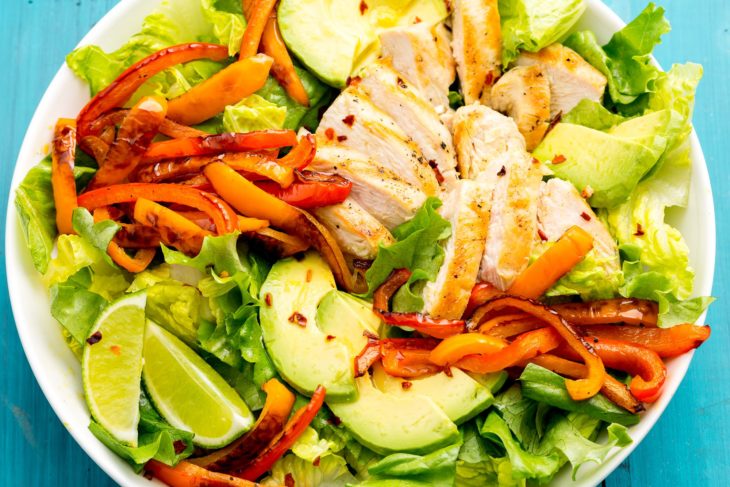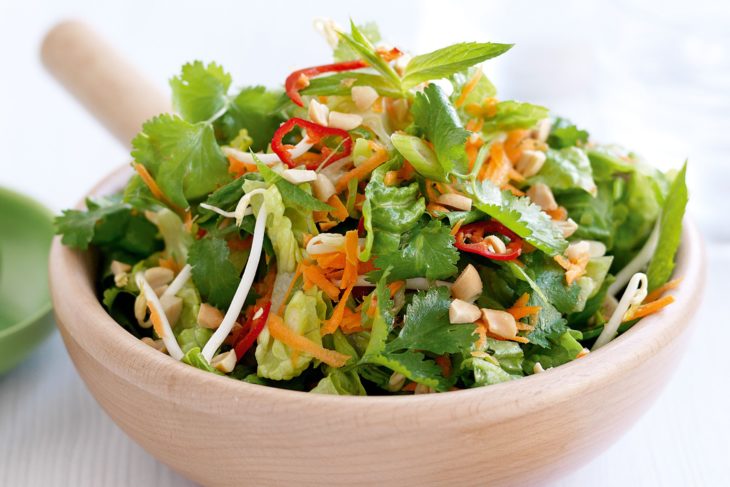Making a salad at home is a pain in the ass and everyone knows it. Too much chopping! Too much washing! Too many partially-used ingredients sitting in your fridge afterward! BAH HUMBUG. NO SALAD.
Just kidding. I love salad. Greens are the most nutrient-dense food on the planet, and we as much as we can get of leafy stuff in our diet. A palatable salad is the easiest way to do that, but most of the salads you’ve ever eaten are probably not super-palatable.
Fear not! I will teach you how to make a salad you don’t hate at home, and keep the ingredients in constant stock so that you don’t have to worry about a separate trip to the store in order to make a salad in the first place. Soon, you’ll be on the way to Popeye-like spinach strength! …Or at least a lot more fiber and vitamins in your diet, which is definitely good enough.
Contents
Step One: Figure out what kind of greens you like to eat.
Skip the iceberg lettuce, because iceberg lettuce is both tasteless and pointless. People generally just use iceberg lettuce as a solid carrier for salad dressing, which is a practice that’ll becoming exponentially less appealing very quickly. Besides, iceberg lettuce has no nutrients, which negates the purpose of eating salad.
What you really want is for your greens to be adding flavor to the salad so that you don’t have to depend so heavily on salad dressing. Here are a few suggestions:
-
Spinach: A little sweet, and usually very soft.
-
Kale: Crunchy and fibrous, earthy-tasting, and a little bit bitter.
-
Arugula: Medium consistency, and very bitter.
-
Bibb: Soft, with a very mild flavor.
-
Cabbage: Very crunchy, pretty bitter.
-
Chard and Beet Greens: Bitter and a little salty, medium consistency.
-
Endive: Soft and bitter.
-
Mesclun or Spring Greens: A mix, so it depends on what’s included, but usually medium consistency, just slightly bitter.
If you don’t know what kind of greens you like, you can always go to a health food store and ask a produce employee to try a few leaves of different kinds of lettuce and greens. If you really, truly hate the way something tastes, don’t buy it just because you “should” – but try to acclimate yourself to the taste of greens that are a little more bitter than you’re used to. Once you find something you like, buy it in one of those pre-prepared, pre-cut, pre-washed boxes and save yourself the effort.

Source: Delish.com
Step Two: Think about what you can add to the salad for texture that you like to eat anyway.
You want to try and hit a few different categories of foods to put into your salad. Ideally, for a salad that’s nutritionally diverse, you should have fruits and/or vegetables that can add sour, salty, and sweet flavors to the salad; a source of fats like olives, avocado, nuts, or seeds; a protein source like cheese, soy, meat, eggs, or beans; and as well, you want to make sure that you have a variety of textures – crunchy, chewy, soft, fibrous. And, of course – skip the croutons. If you want something crunchy in your salad, nuts are way more nutritious!
A few really great flavor combinations:
-
Mango, red cabbage, edamame, carrots, and ginger
-
Shallots, almonds, and parmesan
-
Multi-color bell peppers, spicy chicken, red onion, grapefruit, avocado
-
Celery, dried cranberries, pine nuts, apples
-
Fennel, parmesan, celery, and Italian sausage
-
Beets, goat cheese, orange, and hazelnuts
-
Lentils, feta, tomatoes, kalamata olives, and pecans
…And on and on it goes! The same as with greens, pick salad ingredients that you like and want to eat. Build your salad around your tastes so that you’ll want to eat it as often as possible, and so that you’ll want to keep the ingredients around your house.
Step Three: Keep your dressing simple.
Skip the bottled salad dressings: They are totally unnecessary. Instead, keep a bottle of olive oil around, and a few different sorts of citrus juices and vinegars. Lemon juice and olive oil suffices for salad dressing in almost any situation; lime juice and olive oil is a good alternative, and of course, balsamic vinegar and olive oil is great for Greek-inspired salads. You don’t want the dressing to be the centerpiece of the salad, just a way to lubricate the greens and add a little bit of flavor. Mix it as needed – less than a teaspoon of olive oil and juice or vinegar each should do the trick for one salad – so that none of it goes bad and goes to waste.

Source: Taste
Step Four: Assemble it in the right order – with bonus secret salad trick!
When you assemble your salad, you want to put the greens in a bowl first, then coat them in the dressing by tossing them. Then – and here’s the secret salad trick – I highly, highly recommend keeping a box of coarse salt around your kitchen. After you coat the greens in dressing, mix in a pinch of the coarse salt. It is heaven.
I generally, then, mix in cheese, nuts, dried fruit, and any other small ingredients, and then top it with fruits or vegetables, and finish it with meat, if you’re using it. It’ll make it look prettier and more appealing.
Beyond creating a salad that tastes good to you, the point of keeping your salad ingredients limited to things that you already like to eat is that you’ll have more of an incentive to buy them on your regular grocery shopping trips, bring them home, and prepare them ahead of time (chopping fruits and vegetables and storing them in containers in the fridge, or cooking meats and beans). So all in all, with pre-prepped ingredients, it should take you maybe 5 minutes to assemble your whole salad. You want to design your whole salad-making process so that you associate salads with both ease and deliciousness, and therefore subconsciously begin to crave salads more.
So there you go! Start planning out your salad staples, and welcome to a whole new world of nutrition!
Original by Rebecca Vipond Brink
